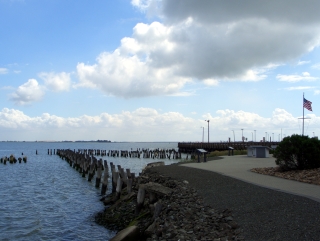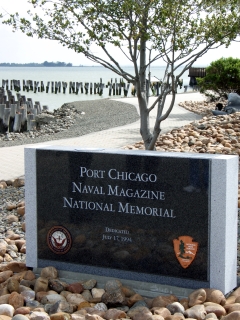NPS Website
 WHAT IS IT?
WHAT IS IT?Site of a July 17, 1944 ammunitions explosion that blew up two ships parked side-by-side on a loading pier and killed over 300 men. Port Chicago was the largest stateside disaster during World War II. Over 200 of those killed were enlisted African American seaman, 15% of all WWII African American deaths.
BEAUTY (4/10)
The Memorial consists of a small granite block commemorating the dedication. The names of those who died are etched in four table-top granite plaques that look out onto the remnants of the destroyed pier in the Carquinez Strait. You are looking out onto a watery graveyard. It is a chilling site. A mangled piece of metal sits near the plaques unmarked. The Ranger told us that it is a piece of one of the detonated ships. We are sure it has some stories to tell.
HISTORICAL INTEREST (7/10)
Many factors led to the incredible tragedy of Port Chicago: a segregated military force, no training for ammunition loaders, the loaded ammunition was live and two ships were loaded simultaneously side-by-side. The Navy addressed all these problems within years of the explosion largely because of the lessons learned at Port Chicago.
However, the pull of Port Chicago on our American psyche does not end there. The Port Chicago disaster holds great historical interest because it has been effectively erased from our collective national memory. It is not a story we repeat about our greatest generation.
The African-American’s at Port Chicago had enlisted in the Navy with the understanding that they would be fighting overseas. Instead, the Navy sent them to Concord, California to load live ammunition.
Immediately following the disaster, other African American regiments spent the next weeks cleaning up the destruction, taking in the loss of their fellow seamen. The devastation caused by 5,000 tons of explosion was removed in just three weeks. At that point, the seamen were ordered to begin loading ammunition again, in the same way and in the same place where their fellow seamen had fallen.
Three divisions, 328 men, agreed to keep working but refused to load the dangerous ammunition. They were all taken into custody, 258 of them imprisoned on a floating barge and charged with mutiny. The threat of firing squad dwindled the number of resisters to 50.
The Court Martial began in September of 1944, the judgment coming soon after: dishonorable discharge and 8 to 15 years in jail. Future Supreme Court Justice and then NAACP attorney, Thurgood Marshall, watched the trial and was disturbed by its “obvious racism”. He argued for the seaman’s benefit before public officials and for the press. President Truman agreed and released the men once the War ended. The Court Martial and the explosion are often cited as the reason Truman desegregated the military in 1948.
The Navy has never taken responsibility for the disaster. They have always blamed the soldiers. Racism sears through their argument. The families of the fallen African American seamen have never been compensated. In contrast, the Navy immediately compensated the families of white Officers who died in the blast.
The memorial to the fallen seamen took 50 years to build. The remembrance saw the light of day only because of the tireless ten-year lobbying of a local Congressman and a President with a sympathetic ear. Five years after the memorial’s dedication, in 1999, President Clinton pardoned the 50 mutineers. Only one of the soldiers accepted the pardon, the others still believe they had done nothing wrong.
CROWDS (8/10)
The high security atmosphere of a working military base prevents you from driving to the Memorial. Instead, you drive to the base’s entrance, a Park Ranger picks you up in a minivan and drives you to the explosion site. We toured the Site with a retired African American man, his wife and daughter. He had served in the Navy. He was very familiar with the Port Chicago explosion. He and his family added a perspective and understanding to our visit that we would not have had without them.
An unexpected participant in our visit was an on-duty Federal police officer. He trailed the NPS minivan in an SUV and watched us closely during our entire stay. We followed the NPS Ranger’s rules and kept our camera focused on only the Memorial.
 EASE OF USE/ACCESS (1/5)
EASE OF USE/ACCESS (1/5)Port Chicago NMEM is located on the still-active Concord Naval Weapons Station. Access is very limited. You must arrange your visit ahead of time with a National Parks Service Ranger. The phone number is (925) 838-0249. Tours are available Wednesday through Saturday. In addition, no civilians are allowed on the base while the Weapons Station is handling live ammunition. Our request took three weeks to process (because of live ammo) and we knew our tour was OK’d only a day prior to our visit.
Parts of the base have been included on the most recent base closure list. Contrary to most communities, Concord is eager for the base to close; they want the prime real estate developed. Accessing the Memorial will be much easier once the base closes.
CONCESSIONS/BOOKSTORE (1/5)
The Site has no bookstore.
COSTS (5/5)
Port Chicago NMEM must be visited via a guided Ranger tour. Both the tour and entry are free.
RANGER/GUIDE TO TOURIST RATIO (4/5)
One wonderful and tireless woman is the only Ranger that gives the mandatory tours at both Port Chicago NMEM and the Eugene O’Neill Tao House. She is it at both places. Nonetheless, five tourists to one Ranger was not a bad ratio.
TOURS/CLASSES (8/10)
Our Ranger-led tour was terrific, just as educational, thought provoking, and in-depth as an intensive graduate school level class. Our Ranger Tour Guide had a tangible passion to teach about the events at Port Chicago. She brought additional reading materials, pictures and histories into the minivan for us to peruse post-tour. Her tour illuminated an episode in American history that we knew nothing about despite not having what most Park sites enjoy: a Museum or even an official Parks Pamphlet.
FUN (5/10)
Port Chicago NMEM offers no easy answers. Questions of racism, mutiny during wartime, segregation and the Navy’s indifference are hard to address and fully comprehend when you are staring at a place where hundreds died. It is even harder to discern any truths because the Port Chicago explosion is such an unknown historical event. Our visit was not fun but it was very effective at stirring other emotions. We were disturbed, moved, angered, sympathetic and confused.
The only definitive conclusion we came to was that it should have never taken 50 years for the United States to memorialize the brave 300+ seamen who gave their lives to our country at Port Chicago.
WOULD WE RECOMMEND? (5/10)
Visiting the Port Chicago NMEM is difficult logistically and emotionally, but the men who died here should not remain forgotten. If you live nearby, a weekend visit makes for a powerful educational experience and is recommended.
TOTAL 46/80
www.usa-c2c.com
© 2005